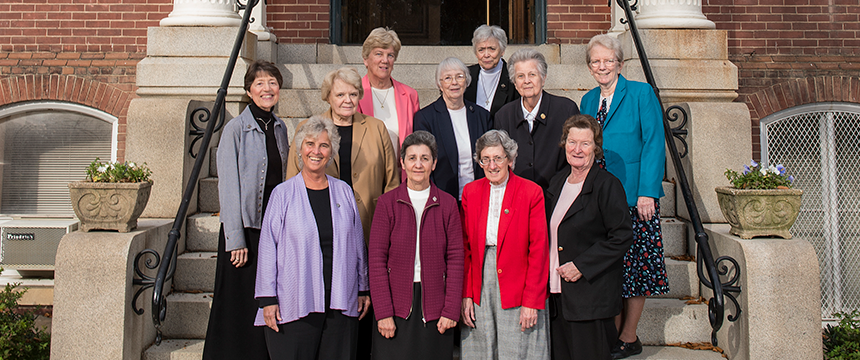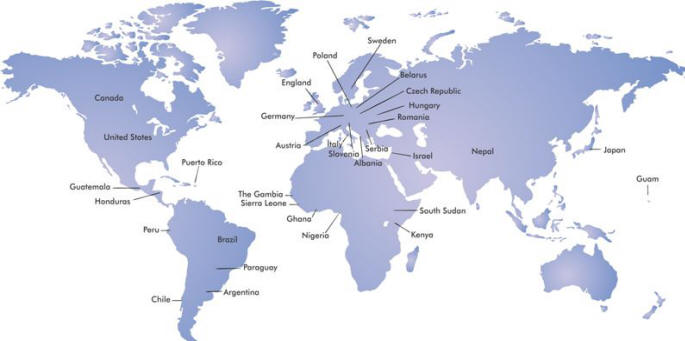In the Beginning
Caroline Gerhardinger (1797-1879) lived during turbulent times in Bavaria. At the age of 15, she was already a certified teacher in the school for girls in Stadtamhof near Regensburg. She was a very gifted educator whose enthusiastic and encouraging acceptance of the children soon made her a beloved teacher. Under the spiritual guidance of Bishop George Michael Wittmann (1760-1833), Caroline gradually recognized God’s call to found a religious community in order to respond to the needs of the times through education. On November 16, 1835, Caroline professed her religious vows and took the name Mary Theresa of Jesus. Blessed Theresa anchored her community in poverty and dedicated it to Mary. In 1839, Blessed Theresa wrote at a time when there were 14 professed sisters these prescient words that would aptly describe the future of the School Sisters of Notre Dame: “United and content with little, we go out into the whole world, into the tiniest villages, into the poorest dwellings, wherever the Lord calls us, to bring poor children the good news of God’s reign.”
Journey to America
In June 1847, five women led by Mother Theresa Gerhardinger set out from their motherhouse in Munich, Germany, for the port city of Bremen, where they boarded the SS Washington, bound for the United States. These women, vested in the habit of the School Sisters of Notre Dame, faced an uncertain future on a path that would eventually lead to a hilltop campus in Baltimore.
They had been invited to start a school in southwestern Pennsylvania. The Benziger and Eschbach Company of Einsiedeln, Switzerland, had purchased the land with the intention of selling plots to emigrating German Catholics and developing a town called St. Mary’s. A certain Baron von Schroeder, sent by the company as an emissary to accompany the Sisters, assured them they would be welcomed upon their arrival by the bishop of Pittsburgh. What could be more auspicious than to begin a new venture in a place named after Notre Dame, Our Lady, the mother of Jesus?
But troubles began soon after Mother Theresa and her companions disembarked in New York. The Redemptorist Fathers they visited warned them not to commit to St. Mary’s: it was sparsely populated, and, most importantly, it was not located on a trade route. The town faced a bleak future. Then, on the journey overland, one of their band, a novice named Mary Emmanuel, fell ill in Harrisburg, Pa., and died. The grieving Sisters buried her and continued by coach on the rugged road. According to a diary entry by one of the Sisters, “The muddy water from the puddles through which we drove splashed over our heads and fell upon our clothing. Hanging boughs struck us in the faces; we were sorry-looking objects.”
The Sisters began wondering if they would ever reach their destination, according to an account written by Sister Mary David Cameron, SSND: “On the evening after the third day out of Harrisburg, they looked around them at the log huts scattered sparsely over a clearing in the forest and asked the baron how soon they would reach St. Mary’s. ‘Why,’ he said, ‘you are already in the heart of the city!’”
To top it off, the bishop of Pittsburgh had never heard the Sisters were coming and wasn’t particularly welcoming. Mother Theresa later recalled his greeting: “I am very much surprised at your arrival."
The Sisters had every reason to retrace their steps onto the decks of the first boat back to Bremen. But they didn’t. They moved into a small frame convent, got to work, and soon had the school up and running. But Mother Theresa was soon convinced that St. Mary’s was no place for a motherhouse, and she traveled to Baltimore to consult with Father John Neumann, the future saint who was then provincial of the Redemptorists. With his encouragement, she accepted an offer from the Redemptorists to staff schools in their parishes, and by the autumn of 1847 the Sisters began teaching in three parishes in Baltimore.
The Founding of Notre Dame of Maryland
In 1871 the sisters selected a beautiful 33-acre site in North Baltimore that would accommodate its burgeoning student populations as well as future expansion. In 1873, Notre Dame of Maryland Collegiate Institute, educating both elementary and high school-aged girls, opened on Charles Street, where the present University is located today. As the turn of the century neared, the SSNDs had developed an international reputation for the quality and rigor of their teaching.
The SSNDs established College of Notre Dame of Maryland in 1895 as the first Catholic college for women in the United States to award the four-year baccalaureate degree. A press clipping from the time commended the new college for its curriculum that would “meet the ever increasing demand to give women the opportunity for intellectual training as thorough and comprehensive as is afforded to men in the best colleges of the country.” Six young women were in the first graduating class: Helen Burr of Lincoln, Neb.; Mary Teresa Curran of Andover, Mass.; Dorothea Kilkoff of Deland, Fla.; Louise Power of San Francisco; and sisters Catherine and Ellen Coll from Baltimore.
Read more about the history of Notre Dame of Maryland University.



